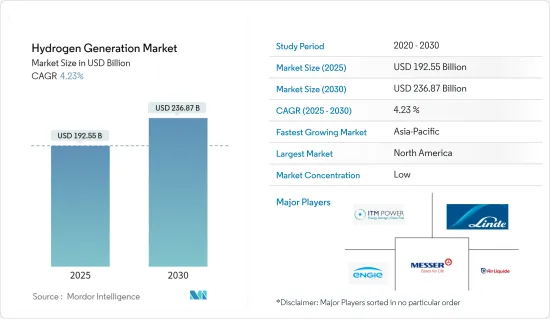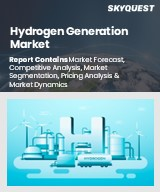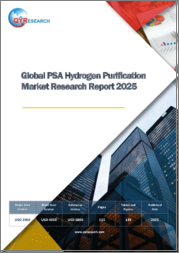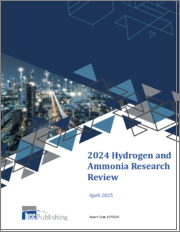
|
시장보고서
상품코드
1692104
수소 생성 : 시장 점유율 분석, 산업 동향 및 통계, 성장 예측(2025-2030년)Hydrogen Generation - Market Share Analysis, Industry Trends & Statistics, Growth Forecasts (2025 - 2030) |
||||||
수소 생성 시장 규모는 2025년에 1,925억 5,000만 달러로 추정되고, 2030년에는 2,368억 7,000만 달러에 달할 것으로 예측되고, 예측 기간 중(2025-2030년)의 CAGR은 4.23%를 나타낼 전망입니다.

중기적으로는 정유소 및 산업 부문의 수요 증가와 함께 정부 지원 정책과 같은 요인이 예측 기간 동안 수소 발전 시장을 주도할 것으로 보입니다.
주요 하이라이트
- 반면에 수소 에너지 저장의 높은 생산 비용은 수소 발전 시장을 제한 할 것으로 예상됩니다.
- 하지만 재생 가능 자원에서 수소를 추출하는 기술 발전과 연료로서의 수소 적용 증가는 예측 기간 동안 수소 생성 시장에 수익성있는 성장 기회를 창출 할 가능성이 높습니다.
- 아시아태평양은 수소 수요 증가로 인해 예측 기간 동안 가장 빠르게 성장하는 시장입니다.
수소 생성 시장 동향
석유 정제 부문이 시장을 독점할 전망
- 석유 정제에서 수소의 사용은 필수 불가결합니다. 정유소는 수소 탈황이라는 화학적 분리 공정을 통해 생산되는 연료에서 황을 제거하는 데 수소를 사용합니다. 또한 정유 공장의 수첨 분해 및 개질 공정에도 사용됩니다. 개질은 석유에서 유황 화합물을 제거하여 고급 연료를 얻어 대기 오염을 줄이는 과정입니다.
- 에너지 연구소의 세계 에너지 통계 검토에 따르면 2021년부터 2022년까지 석유 정제 능력은 0.5%의 성장률을 보인 반면, 지난 10년간의 연간 성장률은 0.7%에 그쳤습니다. 아시아태평양 지역의 다양한 예정된 프로젝트로 인해 향후 몇 년 동안 석유 정제 능력은 성장 추세를 따를 것으로 예상됩니다. 또한 청정 연료에 대한 수요, 석유 제품의 탈황을 위한 정부 규제, 원유 품질의 전반적인 하락도 시장의 성장을 견인할 것으로 예상됩니다.
- 미국 에너지 정보국이 제공한 정보에 따르면 아시아와 중동에는 2023년 말까지 가동을 시작했거나 가동 예정인 정유 프로젝트가 최소 9개 이상 있습니다. 이러한 프로젝트는 예정된 용량을 기준으로 볼 때, 완전히 가동되면 전 세계 정유 생산 능력에 하루 290만 배럴(b/d)을 추가로 기여할 것으로 예상됩니다. 따라서 이는 예측 기간 동안 수소 생산에 대한 수요를 견인할 것으로 예상됩니다.
- 석유 수요의 증가 속도와 정유 투자는 계속해서 증가하고 있습니다. 국제에너지기구(IEA)는 2022년 6월 석유 시장 보고서에서 전 세계 순 정제 능력이 2022년 100만 BPD, 2023년에는 160만 BPD 추가로 확대될 것으로 예상하며, 이로 인해 예측 기간 동안 수소 생산에 대한 수요가 증가할 것으로 전망했습니다.
- 또한 석유 정제 부문은 탄소 포집 및 활용과 같이 수소 생산의 탄소 발자국을 줄이는 기술에 투자함으로써 글로벌 지속가능성 목표에 부합하고 친환경 에너지원으로서 수소의 역할에 적극적으로 영향을 미칠 수 있습니다.
- 예를 들어, 2023년 2월 인도의 대표적인 석유 회사인 인도석유공사(IOC)는 2046년까지 운영 활동에서 순배출 제로 달성을 목표로 2조 루피 상당의 친환경 혁신 전략에 착수했습니다. 이 일환으로 인도석유공사는 모든 정유공장에 친환경 수소 시설을 구축할 계획입니다.
- 따라서 위에서 언급 한 요점에 따라 석유 정제 부문은 예측 기간 동안 시장을 지배 할 것으로 예상됩니다.
아시아태평양 지역에서 가장 빠르게 성장하는 시장
- 아시아태평양 지역은 중국, 인도, 일본 및 한국과 같은 국가가 빠르게 진화하는이 산업의 최전선에있는 글로벌 수소 발전 시장의 중추적 인 플레이어로 부상했습니다. 이러한 역동적인 변화는 깨끗하고 지속 가능한 에너지원에 대한 수요 증가, 탄소 배출을 줄이고 야심찬 기후 목표를 달성하려는 아시아 지역의 노력 등 여러 요인에 기인합니다.
- 각국의 전략, 종합적인 연구, 공동의 노력으로 아시아태평양 수소 발전 시장은 혁신과 투자의 허브로 거듭나고 있습니다. 아시아태평양 수소 발전 시장은 청정 에너지 운반체로서 수소의 잠재력을 활용하기 위한 다양한 기술과 프로젝트가 진행되고 있는 것이 특징입니다.
- 2022년 중국 정부는 2021년부터 2035년까지를 아우르는 수소에 대한 첫 번째 장기 청사진을 발표했습니다.
- 마찬가지로 인도도 정부 및 민간 부문 차원에서 다양한 노력을 통해 친환경 수소를 추구하고 있습니다.
- 여러 기업과 연구 기관이 수소 생산의 실행 가능성을 평가하기 위해 파일럿 프로젝트와 파트너십에 참여하고 있습니다.
- 예를 들어, 2023년 5월 도쿄공대 에너지정보학연구소와 협력하여 도쿄공대 인포사이에너지 연구 및 교육 컨소시엄은 폐플라스틱에서 추출한 수소와 수소를 조합하여 전기를 생산할 수 있는 연료 전지를 도입했습니다.
- 따라서 위에서 언급 한 사항에 따라 아시아태평양 지역은 예측 기간 동안 상당한 성장을 보일 것으로 예상됩니다.
수소 생성 산업 개요
수소 발전 시장은 적당히 세분화되어 있습니다. 시장의 주요 업체 중 일부(특별한 순서 없음)는 ITM Power plc, Linde plc, Engie SA, The Messer Group GmbH 및 Air Liquide SA를 포함합니다.
기타 혜택
- 엑셀 형식 시장 예측(ME) 시트
- 3개월간의 애널리스트 지원
목차
제1장 서론
- 조사 범위
- 시장의 정의
- 조사의 전제
제2장 주요 요약
제3장 조사 방법
제4장 시장 개요
- 소개
- 시장 규모 및 수요 예측(-2028년)
- 최근 동향과 개발
- 정부의 규제와 정책
- 시장 역학
- 성장 촉진요인
- 유리한 정부 정책
- 석유 정제 및 산업 부문의 수요 증가
- 억제요인
- 더 높은 생산 비용
- 성장 촉진요인
- 공급망 분석
- Porter's Five Forces 분석
- 공급기업의 협상력
- 소비자의 협상력
- 신규 참가업체의 위협
- 대체품의 위협
- 경쟁 기업간 경쟁 관계
제5장 시장 세분화
- 유래
- 블루 수소
- 그린 수소
- 회색 수소
- 기술
- 증기 메탄 개질(SMR)
- 석탄 가스화
- 기타 기술
- 용도
- 석유 정제
- 화학처리
- 철강 생산
- 기타 용도
- 지역별 시장 분석
- 북미
- 미국
- 캐나다
- 기타 북미
- 유럽
- 독일
- 프랑스
- 이탈리아
- 영국
- 러시아 연방
- 기타 유럽
- 중동 및 아프리카
- 사우디아라비아
- 아랍에미리트(UAE)
- 남아프리카
- 기타 중동 및 아프리카
- 아시아태평양
- 중국
- 인도
- 일본
- 한국
- 기타 아시아태평양
- 남미
- 브라질
- 아르헨티나
- 기타 남미
- 북미
제6장 경쟁 구도
- 합병, 인수, 제휴, 합작 사업
- 주요 기업의 전략
- 기업 프로파일
- Linde plc
- Air Liquide
- Messer Group GmbH
- ITM Power plc
- Engie SA
- Cummins
- Air Products & Chemicals
- Fuel Cell Energy
- Taiyo Nippon
- McPhy Energy
- Enapter
제7장 시장 기회와 앞으로의 동향
- 기술발전
The Hydrogen Generation Market size is estimated at USD 192.55 billion in 2025, and is expected to reach USD 236.87 billion by 2030, at a CAGR of 4.23% during the forecast period (2025-2030).

Over the medium term, factors such as supportive government policies coupled with the increasing demand from refineries and the industrial sector are likely to drive the hydrogen generation market during the forecast period.
Key Highlights
- On the other hand, high production costs of hydrogen energy storage are expected to restrain the hydrogen generation market.
- Nevertheless, technological advancements in extracting hydrogen from renewable sources and increased applications of hydrogen as a fuel are likely to create lucrative growth opportunities for the hydrogen generation market during the forecast period.
- Asia-Pacific is the fastest-growing market during the forecast period due to the rising hydrogen demand. This growth is attributed to increasing investments, coupled with supportive government policies in the countries such as India, China, and Japan.
Hydrogen Generation Market Trends
Oil Refining Segment Expected to Dominate the Market
- The use of hydrogen in oil refining is indispensable. Oil refineries are used to remove sulfur from the fuels they produce in a chemical separation process called hydro desulphurization. It is also used for hydro-cracking and reforming processes in oil refineries. Reforming is the process of removal of sulfur compounds from petroleum to obtain high-grade fuel, thus reducing air pollution. Hydrogen is added to crude oil and oxygen to deliver refined petroleum products (e.g., diesel, LPG, and gasoline).
- According to the Energy Institute Statistical Review of World Energy, the oil refining capacity witnessed a growth rate of 0.5% between 2021 and 2022, whereas the annual growth rate in the last decade was 0.7%. The oil refining capacity is expected to follow the growth trend in the coming years due to various upcoming projects in the Asia-Pacific region. The market's growth is also expected to be driven by the demand for cleaner fuels, government regulations for the desulfurization of petroleum products, and the general decline in crude oil quality. As the rate of crude decreases, the volume of hydrogen required for the refinement process increases to maintain the quality of end products.
- As per the information provided by the US Energy Information Administration, there are at least nine refinery projects in Asia and the Middle East that are in the process of commencing operations or were slated to become operational by the conclusion of 2023. These projects, based on their intended capacities, are expected to contribute an additional 2.9 million barrels per day (b/d) to the global refinery capacity when they reach full operational status. Thus, this is anticipated to drive the demand for hydrogen generation during the forecast period.
- The pace and refinery investments continue to follow the increase in the oil demand. In the International Energy Agency's (IEA) June 2022 Oil Market Report, the IEA expects net global refining capacity to expand by one million BPD in 2022 and by an additional 1.6 million BPD in 2023, which is expected to increase the demand for hydrogen generation during the forecast period.
- Moreover, by investing in technologies that reduce the carbon footprint of hydrogen production, such as carbon capture and utilization, the oil refining segment can align with global sustainability objectives and proactively influence the role of hydrogen as a green energy source.
- For instance, in February 2023, the leading Indian oil company, Indian Oil Corporation (IOC), embarked on a green transformation strategy worth INR 2 trillion, with the aim of achieving net-zero emissions from its operational activities by 2046. As part of this initiative, Indian Oil Corporation plans to establish green hydrogen facilities at all of its refineries.
- Therefore, as per the points mentioned above, the refinery segment is expected to dominate the market during the forecast period.
Asia-Pacific Region Fastest Growing Market
- The Asia-Pacific region has emerged as a pivotal player in the global hydrogen generation market, with countries like China, India, Japan, and South Korea at the forefront of this rapidly evolving industry. This dynamic shift can be attributed to several factors, including the increasing demand for clean and sustainable energy sources and the region's commitment to reducing carbon emissions and achieving ambitious climate goals.
- These countries' strategic initiatives, comprehensive research, and concerted efforts make the Asia-Pacific hydrogen generation market a hub for innovation and investment. The Asia-Pacific hydrogen generation market is characterized by a diverse range of technologies and projects aimed at harnessing the potential of hydrogen as a clean energy carrier.
- In 2022, the Chinese government unveiled its inaugural long-range blueprint for hydrogen, outlining the period spanning from 2021 to 2035. As per the most recent government blueprint, China aims to manufacture between 100,000 and 200,000 tons of renewable hydrogen each year and establish a fleet of 50,000 hydrogen-powered vehicles by 2025.
- Similarly, India's pursuit of green hydrogen is marked by various initiatives, both at the governmental and private sector levels. The government has introduced several policy measures and incentives to encourage green hydrogen projects and infrastructure development. The National Hydrogen Energy Mission (NHEM), launched by the Indian government, outlines a roadmap for hydrogen production, storage, and utilization.
- Several companies and research institutions are engaged in pilot projects and partnerships to assess the viability of hydrogen production. The country's comprehensive approach, combining green and blue hydrogen initiatives, aligns with its commitment to lowering carbon emissions throughout the hydrogen supply chain.
- For instance, in May 2023, the Tokyo Tech InfoSyEnergy Research and Education Consortium, in collaboration with the Tokyo Tech Academy of Energy and Informatics, introduced a fuel cell capable of producing electricity using a combination of hydrogen and hydrogen derived from waste plastic materials.
- Therefore, as per the points mentioned above, the Asia-Pacific region is expected to witness significant growth during the forecast period.
Hydrogen Generation Industry Overview
The hydrogen generation market is moderately fragmented. Some of the major players in the market (in no particular order) include ITM Power plc, Linde plc, Engie SA, The Messer Group GmbH, and Air Liquide SA.
Additional Benefits:
- The market estimate (ME) sheet in Excel format
- 3 months of analyst support
TABLE OF CONTENTS
1 INTRODUCTION
- 1.1 Scope of the Study
- 1.2 Market Definition
- 1.3 Study Assumptions
2 EXECUTIVE SUMMARY
3 RESEARCH METHODOLOGY
4 MARKET OVERVIEW
- 4.1 Introduction
- 4.2 Market Size and Demand Forecast in USD, till 2028
- 4.3 Recent Trends and Developments
- 4.4 Government Policies and Regulations
- 4.5 Market Dynamics
- 4.5.1 Drivers
- 4.5.1.1 Favorable Government Policies
- 4.5.1.2 Increasing Demand From Refinery and Industrial Sector
- 4.5.2 Restraints
- 4.5.2.1 Higher Production Cost
- 4.5.1 Drivers
- 4.6 Supply Chain Analysis
- 4.7 Porter's Five Forces Analysis
- 4.7.1 Bargaining Power of Suppliers
- 4.7.2 Bargaining Power of Consumers
- 4.7.3 Threat of New Entrants
- 4.7.4 Threat of Substitutes Products and Services
- 4.7.5 Intensity of Competitive Rivalry
5 MARKET SEGMENTATION
- 5.1 Source
- 5.1.1 Blue hydrogen
- 5.1.2 Green hydrogen
- 5.1.3 Grey Hydrogen
- 5.2 Technology
- 5.2.1 Steam Methane Reforming (SMR)
- 5.2.2 Coal Gasification
- 5.2.3 Other Technologies
- 5.3 Application
- 5.3.1 Oil Refining
- 5.3.2 Chemical Processing
- 5.3.3 Iron & Steel Production
- 5.3.4 Other Applications
- 5.4 Geography (Regional Market Analysis {Market Size and Demand Forecast till 2028 (for regions only)})
- 5.4.1 North America
- 5.4.1.1 United States
- 5.4.1.2 Canada
- 5.4.1.3 Rest of North America
- 5.4.2 Europe
- 5.4.2.1 Germany
- 5.4.2.2 France
- 5.4.2.3 Italy
- 5.4.2.4 United Kingdom
- 5.4.2.5 Russian Federation
- 5.4.2.6 Rest of Europe
- 5.4.3 Middle East & Africa
- 5.4.3.1 Saudi Arabia
- 5.4.3.2 United Arab Emirates
- 5.4.3.3 South Africa
- 5.4.3.4 Rest of Middle East and Africa
- 5.4.4 Asia-Pacific
- 5.4.4.1 China
- 5.4.4.2 India
- 5.4.4.3 Japan
- 5.4.4.4 South Korea
- 5.4.4.5 Rest of Asia-Pacific
- 5.4.5 South America
- 5.4.5.1 Brazil
- 5.4.5.2 Argentina
- 5.4.5.3 Rest of South America
- 5.4.1 North America
6 COMPETITIVE LANDSCAPE
- 6.1 Mergers, Acquisitions, Collaboration and Joint Ventures
- 6.2 Strategies Adopted by Key Players
- 6.3 Company Profiles
- 6.3.1 Linde plc
- 6.3.2 Air Liquide
- 6.3.3 Messer Group GmbH
- 6.3.4 ITM Power plc
- 6.3.5 Engie SA
- 6.3.6 Cummins
- 6.3.7 Air Products & Chemicals
- 6.3.8 Fuel Cell Energy
- 6.3.9 Taiyo Nippon
- 6.3.10 McPhy Energy
- 6.3.11 Enapter
7 MARKET OPPORTUNITIES AND FUTURE TRENDS
- 7.1 Technological Advancements



















